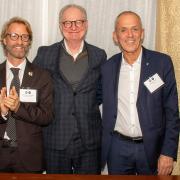When trying to answer questions as deep as “what makes up the universe,” advance planning is key.
On June 11, the National Academies of Science, Engineering and Medicine announced the result of a three-year study to set a vision for the next decades of particle physics—the field of science that studies the fundamental forces and particles of the universe.
Known as “Elementary Particle Physics: The Higgs and Beyond” and undertaken at the request of the U.S. National Science Foundation and Department of Energy, the study is intended to help guide federal agencies, policymakers and academics as they make decisions about research, funding and planning for the field. Eighteen physicists from around the world, including several from the University of Chicago, participated in the committee.
The committee’s top recommendation is that the U.S. build a muon collider, an ambitious, first-of-its-kind project that would accelerate muons, which are heavier cousins of the electron. Such a collider, hosted at UChicago-affiliated Fermi National Accelerator Laboratory, could smash particles at 10 times the energy of the Large Hadron Collider at CERN, but would fit on a single site rather than across multiple countries.
Scientists hope the muon collider could discover the particle that comprises the mysterious dark matter, as well as lead to hints about other big questions in the field.
“Humans are on the threshold of understanding the origin of matter, energy, space and time,” said Michael Turner, the Rauner Distinguished Service Professor Emeritus of Physics at UChicago, who co-chaired the committee along with Caltech physicist Maria Spiropulu. “This is our vision for where we think the field can be in 40 years, and what we need to do to realize all the opportunities we have.”
Turner is one of several UChicago-affiliated scientists on the committee, along with fellow physicists Young-Kee Kim, Marcela Carena, Bonnie Fleming and Salman Habib.
The ‘most exciting questions’
While humans have built an impressively comprehensive framework for our understanding of the universe, questions remain.
There’s the mysterious stuff known as dark matter, which appears to be holding galaxies together but cannot yet be directly measured. There’s the question of why more matter exists in the universe than antimatter; how Albert Einstein’s theory of general relativity fits in with quantum mechanics; and the nature of the even more mysterious dark energy pushing the universe apart.
The new National Academies committee’s mission is to consider these and other outstanding questions and how they could be addressed. The last such report was completed in 2006, when the Large Hadron Collider was under construction.
“This long-awaited report sets a bold new vision for particle physics that would place Fermilab squarely at the forefront of next-generation scientific research and discovery," said Kim, who is the Fermilab director. "The development of the world’s highest-energy particle collider at Fermilab is an exciting prospect that would impact the future for particle physics in the coming decades."
The muon collider recommended by the report would similarly take years of advance testing and planning, to be completed by midcentury. Scientists hope that the experiment would reveal much more detail about the Higgs boson and other questions—all with a smaller space and electricity footprint than the proton collisions at the Large Hadron Collider.
“Developing a U.S.-hosted muon collider—an unprecedented machine requiring considerable research, development, and a feasibility demonstrator—would solidify U.S. leadership in particle physics and drive accelerator innovation,” the committee wrote.
“The hallmark of U.S. science is turning the impossible into the merely challenging,” Turner added.
Most particle physics projects today are so large that no one nation can undertake them alone, however. More than 20 countries were involved in the Large Hadron Collider’s construction. The report foresees the importance of this continued international collaboration, for a muon collider as well as other experiments.
In this vein, the report recommends that the U.S. participate in a proposed CERN project to build a “Higgs factory,” to produce large numbers of the elusive particle to answer multiple questions.
“Right now, for example, one of the biggest mysteries is why the Higgs is the only fundamental particle that doesn’t have spin,” said Turner. “The fermions, leptons, quarks, they all have spin. Are there other spinless particles like the Higgs?”
Cosmic mysteries
However, it won’t only be accelerators that make big contributions to particle physics in the future, the scientists said. Cosmological surveys of the sky will play a role, as will ultra-sensitive underground experiments like the Deep Underground Neutrino Experiment, which will send a beam of neutrinos 800 miles through the ground from Fermilab in Illinois to South Dakota to better understand the ghostly particles.
The scientists also noted that while the scientific quest is important for its own sake, there are also benefits to other aspects of human life.
“The quest to understand nature at the most basic level has led to the development of tools, from accelerators and medical imaging devices to the World Wide Web; as well as a highly trained workforce, all of which benefit the nation and society more broadly,” the committee wrote. “If history is any guide, the even deeper understanding of matter, energy, space and time that lies ahead will lead to even more benefits.”

